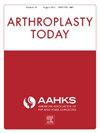Patient Perspective on Robotic-Assisted Total Joint Arthroplasty
IF 1.5
Q3 ORTHOPEDICS
引用次数: 0
Abstract
Background
Robotic-assisted total joint arthroplasty (TJA) has gained popularity in recent years. Despite mixed patient and surgeon perceptions, conflicting evidence regarding efficacy and cost-effectiveness in comparison to manual TJA exists. Patients' beliefs surrounding robotic-assisted TJA remain unclear. This study aims to assess patients' expectations on robotic technology in TJA.
Methods
A 9-question survey assessing patient understanding and expectations of the use of robotics in TJA was distributed to preoperative and postoperative hip and knee patients of five surgeons at a high-volume academic center. Responses were descriptively analyzed.
Results
A total of 498 responses were collected. Of all respondents, 69.1% are aware of robotic usage in TJA, 68.5% are interested but unsure of the benefits, and only 19.5% feel it is superior to manual surgery. Most patients did not consider robotic TJA as minimally invasive surgery, with 61.7% stating they are not the same. In addition, 52.3% were not comfortable with extra or longer incisions for robotic procedures. Regarding surgeon choice, 94.9% did not consider if the surgeon is able to perform robotic TJA, 74.4% wanted their surgeon proficient in manual TJA, and 72.4% felt that surgeons who use robotic technology are not more capable than manual surgeons.
Conclusions
Awareness and curiosity of robotic-assisted TJA exists; however, most patients did not appear to acknowledge superiority or benefits over manual surgery. Furthermore, patients appear to prefer surgeon proficiency in manual techniques, which may influence training programs in the future. Surgeons should weigh patient goals, expectations, outcomes, and costs when choosing to perform robotic TJA.
患者对机器人辅助全关节成形术的看法。
背景:机器人辅助全关节置换术(TJA)近年来越来越受欢迎。尽管患者和外科医生的看法不一,但与手工TJA相比,关于疗效和成本效益的证据相互矛盾。患者对机器人辅助TJA的看法尚不清楚。本研究旨在评估患者对机器人技术在TJA中的期望。方法:对某大容量学术中心的5位外科医生的髋关节和膝关节术前和术后患者进行9个问题的调查,评估患者对机器人技术在TJA中使用的理解和期望。对反馈进行描述性分析。结果:共收集问卷498份。在所有受访者中,69.1%的人知道机器人在TJA中的使用,68.5%的人感兴趣但不确定好处,只有19.5%的人认为它优于人工手术。大多数患者不认为机器人TJA是微创手术,61.7%的患者表示他们不一样。此外,52.3%的人对机器人手术的额外或更长的切口感到不舒服。在选择外科医生时,94.9%的人不考虑外科医生是否会进行机器人TJA, 74.4%的人希望他们的外科医生熟练进行手动TJA, 72.4%的人认为使用机器人技术的外科医生并不比手动外科医生更有能力。结论:存在机器人辅助TJA的意识和好奇心;然而,大多数患者似乎并不承认人工手术的优越性或益处。此外,患者似乎更喜欢外科医生熟练掌握手工技术,这可能会影响未来的培训计划。在选择机器人TJA时,外科医生应该权衡患者的目标、期望、结果和成本。
本文章由计算机程序翻译,如有差异,请以英文原文为准。
求助全文
约1分钟内获得全文
求助全文
来源期刊

Arthroplasty Today
Medicine-Surgery
CiteScore
2.90
自引率
0.00%
发文量
258
审稿时长
40 weeks
期刊介绍:
Arthroplasty Today is a companion journal to the Journal of Arthroplasty. The journal Arthroplasty Today brings together the clinical and scientific foundations for joint replacement of the hip and knee in an open-access, online format. Arthroplasty Today solicits manuscripts of the highest quality from all areas of scientific endeavor that relate to joint replacement or the treatment of its complications, including those dealing with patient outcomes, economic and policy issues, prosthetic design, biomechanics, biomaterials, and biologic response to arthroplasty. The journal focuses on case reports. It is the purpose of Arthroplasty Today to present material to practicing orthopaedic surgeons that will keep them abreast of developments in the field, prove useful in the care of patients, and aid in understanding the scientific foundation of this subspecialty area of joint replacement. The international members of the Editorial Board provide a worldwide perspective for the journal''s area of interest. Their participation ensures that each issue of Arthroplasty Today provides the reader with timely, peer-reviewed articles of the highest quality.
 求助内容:
求助内容: 应助结果提醒方式:
应助结果提醒方式:


